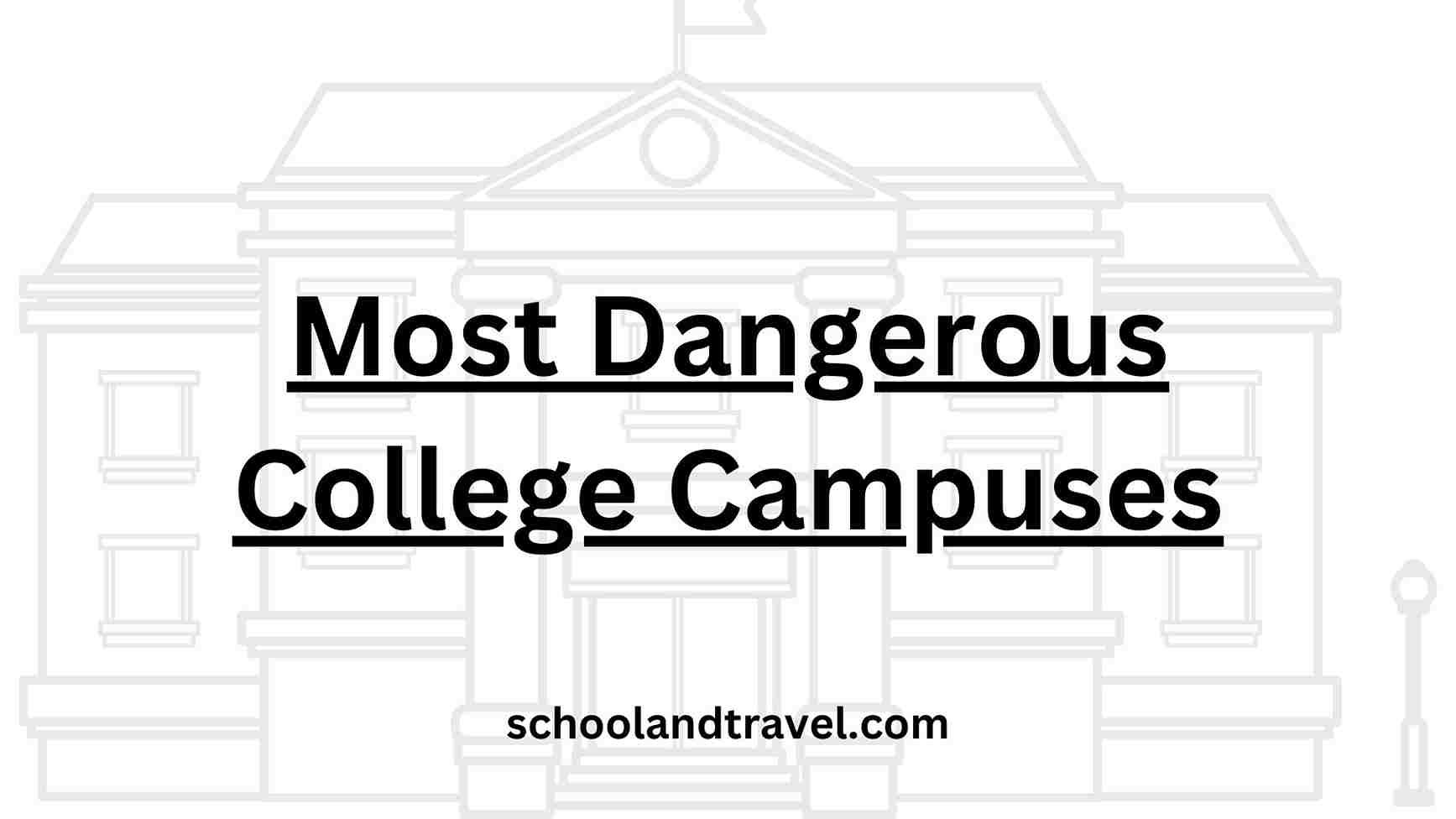In higher education, safety, and security are paramount concerns for students and their families.
As the new academic year dawns, it is essential to highlight campus safety and identify the most dangerous college campuses.
Within the ivy-covered walls and bustling corridors are pockets of concern—where crime rates, incidents, and vulnerabilities have raised eyebrows.
By examining these campuses, we hope to foster awareness, promote dialogue, and inspire action toward creating safer educational environments for all.
Why are these College Campuses tagged ‘Dangerous’?
Colleges are tagged as dangerous campuses based on factors contributing to higher safety concerns.
1. High Crime Rates
Colleges located in areas with high crime rates, including incidents of theft, assault, or other criminal activities, are often considered more dangerous.
2. Violence and Harassment
Instances of violence, including physical altercations, sexual assault, or harassment, can significantly impact the safety of the campus.
3. Substance Abuse
Colleges with a prevalent culture of drug or alcohol abuse may be labeled as dangerous due to the associated risks, such as impaired judgment, increased violence, or accidental injuries.
4. Inadequate Security Measures
Insufficient security measures, such as a lack of surveillance cameras, well-trained security personnel, or secure entry points, can make the campus more vulnerable to criminal activities.
5. Unsafe Environment
Reports of an unsafe or hostile environment, including bullying, hazing, or discrimination, can make a campus dangerous.
6. Gang Activity
The presence of gangs or gang-related activities in the surrounding community can spill over onto college campuses and create an unsafe atmosphere.
7. Lack of Safety Resources
Limited access to resources such as emergency call boxes, well-lit pathways, or counseling services can increase the perception of danger on campus.
8 Dangerous College Campuses
1. The University of Michigan
The University of Michigan, Ann Arbor, despite being a prestigious institution known for its academic excellence, has unfortunately been associated with some safety concerns.
In recent years, reports of crimes, including theft, assault, and sexual offenses, have raised concerns about the campus’s security.
While the university has taken steps to address these issues by implementing safety programs, increasing campus patrols, and enhancing security measures, the size and openness of the campus can still present challenges.
Students and staff must remain vigilant and take advantage of the available resources such as safety escorts, emergency alert systems, and self-defense classes.
By prioritizing safety and fostering a culture of awareness, the University of Michigan can continue striving to create a safer environment for its students and faculty.
2. University of Iowa
The University of Iowa has garnered attention in recent years for concerns regarding campus safety.
Incidents of sexual assault, violence, and theft have contributed to its reputation as a potentially dangerous college campus.
While the university has implemented various security measures, such as emergency call boxes and a campus police force, the reported crime rates remain a cause for concern.
Students and staff have voiced their unease and called for increased efforts to address safety issues.
3. UC Berkeley
UC Berkeley, a prestigious institution known for its academic excellence, has unfortunately been labeled a dangerous college campus due to several factors.
One of the main concerns is the high crime rate in the surrounding area, including incidents of theft, assault, and robbery.
Additionally, protests and demonstrations on campus have occasionally turned violent, leading to clashes between different groups.
The presence of these activities has contributed to a perception of unrest and potential danger on campus.
4. Ohio State University
This prominent institution is known for its academic excellence and vibrant campus life.
However, it has also gained attention for being labeled as a dangerous college campus in specific contexts.
This categorization stems from a combination of factors.
Locating in an urban area with higher crime rates contributes to safety concerns.
Incidents of theft, assault, and other crimes have occurred on or near the campus, impacting the perception of safety.
Though Ohio State University has implemented various security measures and initiatives to address these issues, students and staff must remain vigilant and take necessary precautions to ensure their well-being on campus.
5. University of New Mexico
The University of New Mexico (UNM) has garnered attention as a college campus with safety concerns.
With its location in Albuquerque, a city known for high crime rates, UNM faces the challenges associated with urban environments.
Reports of theft, assault, and drug-related incidents have contributed to the perception of higher risk on campus.
Additionally, there have been violence and harassment, including sexual assault cases, which have raised concerns about campus safety.
While UNM has implemented various security measures and programs to address these issues, the ongoing focus on improving safety remains crucial to ensure the well-being and peace of mind of students, faculty, and staff.
6. University of Utah
The University of Utah has garnered attention recently for being labeled as a dangerous college campus.
Several factors contribute to this perception. One significant concern is the high crime rate in the surrounding area, including theft, assault, and drug-related offenses.
Additionally, there have been reported cases of violence on campus, including sexual assault and harassment.
These incidents have raised concerns about campus safety and security measures.
While the university has taken steps to address these issues and improve safety protocols, the reputation of the University of Utah as a dangerous campus remains.
7. Pennsylvania State University (Penn State)
This institution is renowned for its academic excellence and vibrant campus life.
However, in recent years, there have been concerns about the safety and security of the university, leading to its classification as a potentially dangerous college campus.
One factor contributing to this classification is the size of the university.
With a large student population spread across multiple campuses, it can take time to maintain complete control over safety measures.
Crime incidents, including theft, assault, and drug-related offenses, have been reported on and around the campus, raising concerns among students, parents, and the community.
Additionally, the university’s location in State College, Pennsylvania, exposes it to certain risks associated with the surrounding community.
Factors such as high crime rates, alcohol-related incidents, and occasional instances of violence have further contributed to the perception of Penn State as a potentially dangerous campus.
Although Penn State has taken steps to address safety concerns, such as implementing security measures and providing resources for student well-being, ongoing efforts are necessary to ensure the safety and security of the campus community.
8. Florida State University
Florida State University (FSU) is known for its academic excellence and vibrant campus life.
Unfortunately, it has gained attention for specific safety concerns that have included it in discussions about dangerous college campuses.
Over the years, FSU has faced incidents of violence, including sexual assault and campus shootings, which have raised concerns about the overall safety of the campus.
Additionally, the university is located in Tallahassee, with relatively higher crime rates than the national average.
However, it is essential to note that FSU, like many other institutions, has implemented various safety measures, such as increased campus security, awareness campaigns, and support services, to mitigate these risks and ensure the well-being of its students and staff.
FAQs on the Most Dangerous College Campuses
Alaska has the highest crime rate among the states in the USA. In 2022, Alaska had a crime rate of 32.14 per 1,000 people, including violent and property crimes. With a population of 736,081, Alaska’s high crime rate makes it the state with the highest overall crime rate in the country.
Clemson University is known for having one of the lowest crime rates among universities in the United States. With a crime rate of just 1.02 incidents per 1,000 residents, Clemson is recognized as a secure campus. The university maintains a strong police presence and provides excellent safety resources to ensure the well-being of its students. This commitment to campus safety contributes to Clemson’s reputation as a university with a low crime rate.
San Diego is often considered one of the most affordable cities in the USA for international students. It offers a combination of reasonable living costs and a high quality of life. The city boasts beautiful beaches, scenic parks, and a pleasant climate, making it an attractive destination for students. Additionally, San Diego offers a range of educational institutions and cultural experiences.
According to the data from U.S. News and World Report, the state with the lowest crime rate is based on the occurrences of both violent and property crimes per 100,000 residents. The report reveals that Maine, New Hampshire, and New Jersey are among the 10 states with the lowest crime rates. However, it’s important to note that crime rates can fluctuate over time and vary within different state regions. For the most accurate and up-to-date information on crime rates, it is recommended to refer to official sources such as the Federal Bureau of Investigation (FBI) Uniform Crime Reporting (UCR) program or state-specific crime databases.
Conclusion
As we conclude our exploration of the most dangerous college campuses in 2023, let us remember that knowledge is power.
It is essential to stay informed, prioritize safety, and advocate for more robust security measures on college campuses.
Whether you are a student, parent, educator, or concerned citizen, let us unite to foster safe and secure educational spaces.
Together, we can demand change, implement preventive measures, and strive for a future where every college campus prioritizes the well-being of its community.
Awesome one; I hope this article answers your question.
Editor’s Recommendations:
- Does Gym Count Towards GPA? (Reasons, Argument, FAQs)
- Skidmore College Acceptance Rate (Overview, FAQs)
- 10 Job/Career Descriptions Starting with the Letter “Y” (FAQs)
- The Boston Conservatory Acceptance Rate (Req., FAQs)
- 10 Latest Scamming Format (How to Detect, FAQs)
- Bryn Mawr Acceptance Rate (Overview, GPA, Tips, FAQs)
If you find this article good, please share it with a friend.




